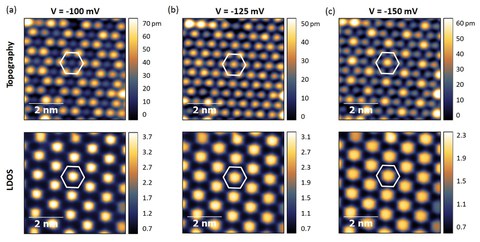Sep 16, 2019
Research: Frustration-driven charge order of surface adatoms
Atomic two-dimensional lattices with a triangular net, experimentally generated by epitaxial submonolayer deposition on an insulating substrate, are intriguingly simple in structure. They provide versatile model systems for the study of strong electron correlations, leading to magnetically or charge-ordered groundstates as well as superconductivity. Here we thoroughly examine the ground state of the triangular lattice of Pb on Si(111) using scanning tunneling microscopy and spectroscopy. We detect electronic charge order, and disentangle this contribution from the atomic configuration which we find to be 1-down—2-up, contrary to previous predictions from density functional theory. Applying an extended variational cluster approach we map out the phase diagram as a function of local and nonlocal Coulomb interactions. Comparing the experimental data with the theoretical modeling leads us to conclude that electron correlations are the driving force of the charge-ordered state in Pb/Si(111). These results resolve the discussion about the origin of the well-known 3 × 3 reconstruction. By exploiting the tunability of correlation strength, hopping parameters, and band filling, this material class represents a promising platform to search for exotic states of matter, in particular, for chiral topological superconductivity.
F. Adler, S. Rachel, M. Laubach, J. Maklar, A. Fleszar, J. Schäfer, R. Claessen,
Correlation-driven charge order in a frustrated two-dimensional atom lattice,
Phys. Rev. Lett. 123, 086401 (2019), (arXiv)

